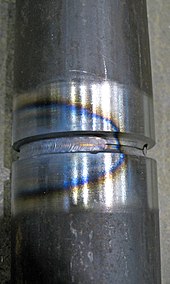Root (welding technique)
The root is at the welding the underside of a weld.
introduction
With single-layer welding in the butt joint, the root is on the side that is not accessible to the welder, e.g. B. because the component is on a table or on the inside of a pipe. In multi-pass welding, the root pass may be produced using a different welding process (e.g. TIG welding ) than the filler and top pass (e.g. MAG welding). The root is in exceptional cases from the root side, i.e. H. the other side than the subsequent layers are welded.
Due to the often high tensile loads in the root, the faultless manufacture of the root is of great importance. Unwelded roots are therefore not permitted in many cases. Especially when using a pool fuse, i. H. a groove in the base supporting the components, a targeted elevation of the root is sought. Elevation of the seam in the root area leads to a notch effect and influences the flow behavior in pipelines and is therefore not permitted in many cases. In special cases, the root is ground with the angle grinder after welding .
Devastating exam

Bending tests can be carried out with the root in the pulling direction. This allows the quality of the root to be assessed using the destructive test.
Non-destructive testing
Detecting unwelded roots with non-destructive methods such as dye penetrant testing , X-rays or ultrasound is possible, but not always reliable. In friction stir welding, for example, the end faces of the butt joint in the unwelded root area are pressed so closely together ( kissing bond ) that they cannot be found using conventional ultrasonic methods as long as they are smaller than the resolution of the test method. If the unwelded root is less than 0.3 mm deep, detection with the ultrasonic method is usually not possible.
Special forms
An unusual special form of welding is 'both sides at the same time', in which a welder stands on each side of a thick-walled component. The weld pools of the two welders meet in the middle without there actually being a root.
